River Surf Systems: River Waves Shaped As Good As The Best Ocean Waves
Watch out river surfers, barrels are not the end game! There’s a new kid in town, River Surf Systems (RSS), and they are about to revolutionise the way we are thinking of wave design. With use of their Reef Pass technology they can mold flowing rivers into surfing waves shaped as good as the best ocean waves. Tanner from RSS has surfed so many perfect ocean waves and now he wants to bring these waves to river surfing. We sat down with the man behind River Surf Systems to learn more about their Reef Pass technology.
We are absolutely stoked about River Surf Systems challenging the limits in wave building! Tell us something about your background Tanner.
 Great to hear from you guys and thanks for spreading the stoke. I’m excited to get my info out there. My quick background is 30 years ocean surfing and three years of wake surfing. I’ve also have 25 years in commercial construction, seven of those as a construction project manager and a Certified Project Management Professional (PMP). Three years of physics in college.
Great to hear from you guys and thanks for spreading the stoke. I’m excited to get my info out there. My quick background is 30 years ocean surfing and three years of wake surfing. I’ve also have 25 years in commercial construction, seven of those as a construction project manager and a Certified Project Management Professional (PMP). Three years of physics in college.
What is your relation to the ocean or rivers surfing community?
I am an ocean surfer with a strong desire to be a river surfer. 2ndlight.com is my local forum for news, photos and stoke. But living in Orlando, I can’t claim to have a real surf community.
River surfers have been dreaming of a barreling river wave since forever. How could River Surf Systems make this dream come true?
Through exhaustive prototyping and experimentation, we are improving the formula for the most economical and feature-rich river waves possible. Barrels are not the end game. A static perfect barrel is an amazing step forward, but variety is the spice of life. These river waves also need variations if they are going to be compared to ocean waves. I have surfed so many perfect ocean waves that I want to bring to river surfing.
Where does your idea to build a barreling river wave come from?
For me this was not a quest to make a barreling river wave specifically. My overreaching goal is a more economical man-made surfing experience whose waves are on par with good ocean waves. I found that river surfing has a distinct advantage over wave pools. No pumps or machinery are needed to move the water. This is a large cost savings over traditional wave pools. The never-ending aspect is a nice bonus too.
Showcasing the many waves the Reef Pass system is capable of is a critical step to gathering support, especially the barrel. Barrels mesmerize people. Including me. I am elated that you guys like the look of the barrel and have given me this opportunity to speak about it.
How does your wave design differ from other wave designs? What are the components that your design is built on and how are they related?
I think current river surfing wave designs take inspiration from their environment. They mimic existing natural river waves and improve on them. I am approaching from a different point of view. I’m asking myself how can we make river waves shaped as good as any ocean wave.
My goal in prototyping was to make waves that looked like ocean waves.
Almost all man-made river waves use a bedform that is perpendicular to the flow. As such the wave is perpendicular to the river and mostly uniform from left to right. Some are hydraulic jumps and many are thick sheet flows.
The Reef Pass system has a deep channel on one side and a shallow curving sand bar on the other. It relies solely on the hydraulic jump phenomenon. On the deeper side of the channel the hydraulic jump is subcritical and a mounded clean green face. On the shallow side the hydraulic jump is a supercritical foamy whitewater. Where the two meet is the lip of the wave. Just like an ocean wave pealing down a point break.
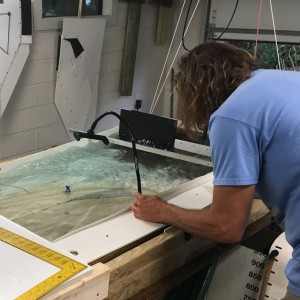 Experimenting With BedformsFor Tanner the answer to the perfect river wave is in the Reef Pass bottom contour.© River Surf Systems
Experimenting With BedformsFor Tanner the answer to the perfect river wave is in the Reef Pass bottom contour.© River Surf Systems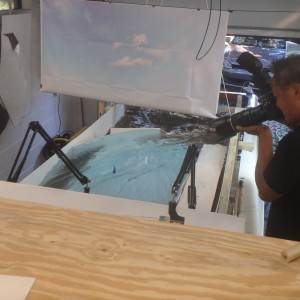 River Wave PrototypingPhoto session in the Oak Island Laboratory.© River Surf Systems
River Wave PrototypingPhoto session in the Oak Island Laboratory.© River Surf Systems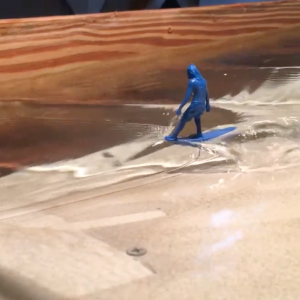 Cheater FiveAt half flow the wave is a knee-high peeling long boarders wave.© River Surf Systems
Cheater FiveAt half flow the wave is a knee-high peeling long boarders wave.© River Surf Systems
What factors are responsible for the wave to barrel? What is the bottom contour like?
The bottom contour is modeled after a reef pass ocean surfing wave. Reef passes are some of the best ocean surfing waves out there.
To create the barrel, a hydraulic jump is controlled and caused to happen in the appropriate place on the Reef Pass bedform and roughly aligns with where a wave would break on a reef pass in real life. In more scientific terms, I am causing a hydraulic jump to simultaneously have all of its incremental depths (phases) and causing it to happen at an angle to the flow. The end result is a vortex known as a barrel to surfers.
How high will the wave be when you scale it up to full size? Can the wave be designed in different dimensions (small to overhead)?
The bottom contour is modeled after a reef pass ocean surfing wave. Reef passes are some of the best ocean surfing waves out there.
Wave size is completely dependent on flow. I am targeting a location that has excess of 4,000 CFS for at least a week out of the year. This will give us a 5 to 6 ft barreling wave at prime season.
River discharges often vary, usually depending on rainfall, dam releases, seasons, or other factors. How can this type of construction deal with changing river flows?
Dealing with variable flow rates and maintaining a surfable wave is a tough technical challenge. Luckily the answer is in the Reef Pass bed form. Some ocean reef passes break for a wide variety of wave sizes. A great example of this is Cloud Break. This world renowned south pacific reef break can be surfed from 2 ft to 20ft.
My prototype shows similar characteristics. At full flow it’s a nice five foot barrel. At half flow it’s a knee-high peeling long boarders wave. At ten percent flow it’s a young beginners long board lump.
So, this is actually an adjustable river wave?
Yes, the wave can be adjusted by manipulating the water flow. Using gates upstream and downstream can change the depth, speed, and direction of the flow, aka vectoring the flow. Depth and speed can control the hydraulic jump. Flow direction changes the angle of incident with the bedform thereby changing the slope the flow passes over.
Deeper, slower water gives softer waves. Faster, thinner water gives us square barrels. A good balance is needed. Synchronising these gates creates smoothly morphing waves of great variety.
A barrel can come to a close and give a tube spit. A racetrack wave can have a lip section for blasting airs or floaters. One moment the wave can be the deepest heavy square tube the next it can be a large soft mounded party wave with 5 SUPs hanging out and passing beers around. All while the river flow provided hasn’t changed.
What do you think will be the challenges when scaling up your model from the lab to the real world?
I think the biggest challenges for me are funding, permits, and living in Orlando. I would like to be involved in the construction process, but that’s hard to do from a thousand miles away.
Depending on the flow the surfing maneuvers would be large and world class.
You may have been asking that question from the point of view of technical wave challenges. With proper prototyping and accurate flow information, I don’t foresee any problems. My work on remodeling theme park rides and hospitals has given me a lot of experience overcoming technical challenges in fast paced sensitive environments.
What are the minimum flow requirements (cfs), drop etc. for your wave to work?
The Reef Pass system wasn’t designed to compete with existing low flow waves. If it is to make a barrel that can be squeezed into, it probably needs about 3,500 cfs. But more experimentation is needed to firm up that estimate.
Have you heard about the prototypes by McLaughlin and fresH20? What similarities or differences compared to your approach do you see?
I talked to Ben about his and Elijah’s wave, and mine, but we didn’t get into specifics of how each design works. We mostly ponder on why the ocean surf community doesn’t see what we see as an opportunity. We also talked about basic parameters of construction and flow. I don’t know the specifics of their wave. Their wave is a hydraulic jump and a barrel.
My goal in prototyping was to make waves that looked like ocean waves. I am happy with the way my waves look. They resemble ocean barrels and lines I want to surf.
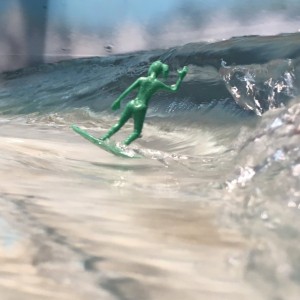 Bottom TurnThe wave will make deep bottom turns and other ocean surfing manoeuvres possible.© River Surf Systems
Bottom TurnThe wave will make deep bottom turns and other ocean surfing manoeuvres possible.© River Surf Systems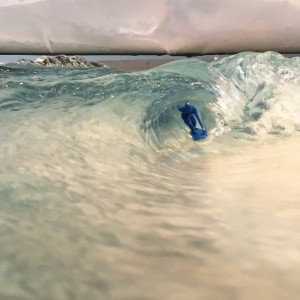 Tubing Through The BarrelBarreling waves is what many river surfers have been dreaming about.© River Surf Systems
Tubing Through The BarrelBarreling waves is what many river surfers have been dreaming about.© River Surf Systems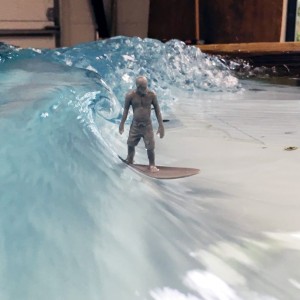 Older Guy River SurfingThe adjustable design allows to create the perfect wave for every surfer.© River Surf Systems
Older Guy River SurfingThe adjustable design allows to create the perfect wave for every surfer.© River Surf Systems
Do you think the tube will be big enough for a surfer to actually hide behind the curtain?
A resounding yes … given we can build it at a location with enough flow.
What would be the main difference for a ocean surfer? What kind of maneuvers you think would be possible?
Compared to ocean surfing the main difference is ride time. Most ocean surfing happens 5 seconds at a time and then your ride is over and you’re looking for another wave. River surfing is near perpetual with respect to water flow. As long as the water is flowing, the wave is standing tall and steady. I anticipate the same maneuvers you see in ocean surfing will immediately adapt. Within a season or two, the groms will likely surprise us with never before seen maneuvers. It’s just what kids do.
How much would such a wave cost?
There are so many variables. The variable I am most interested in is how much flow is it being designed for? More flow means bigger waves, bigger overall installation and higher cost.
A nice steep racetrack wave with a lip would allow for more maneuvers than Eisbach currently does.
If this were to be installed at Riverports Rapids in Oklahoma it could be done for as little as $50k. Most of the whitewater kayak parks already have the infrastructure, especially the pumped ones. This would give us a wave similar in size to Eisbach in Germany, but with better shape. With this small of a water flow the barrel would be too small to squeeze into, but a nice steep racetrack wave with a lip would allow for more maneuvers than Eisbach currently does. This would be a great proving ground for the Reef Pass system.
If this were to be installed at the Ruins Wave in Ottawa I expect it would be closer to $5 million but would give us a stand-up, arms wide barrel. This is the dream. With this much flow the surfing maneuvers would be large and world class.
What other services do you offer? Wave design, feasibility studies, permitting, safety … ?
We excel at wave design and prototyping. We are pretty good at engineering, hydro physics, feasibility studies as it pertains to available flow, and construction project management. I believe Surf Anywhere and McLaughlin Whitewater would be better resources for Permitting, Construction Resourcing, Safety, and many of the other tasks needed to undertake and complete a project like this. Experienced teammates are an important resource.
When will we see this wave being built in an actual river? Any time soon?
I’m busting my ass to make it so. Any advice, help, or connections are appreciated.
Every river surfer dreams of a barreling wave in his backyard. How can people get in touch with you?
Send an email to Tanner@RiverSurfSystems.com
For more details on the prototype and technology please visit my website: RiverSurfSystems.com
Thanks so much for your time Tanner and keep the stoke alive!
Thank you too – really happy to talk surf with you!

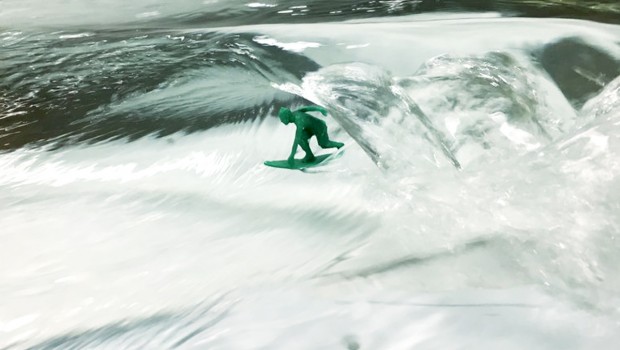
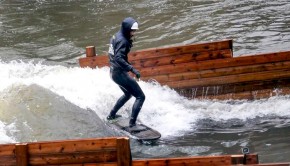
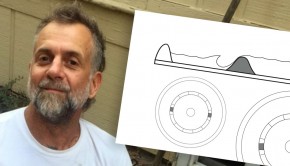
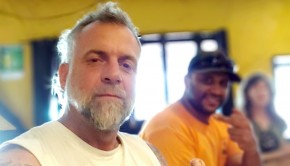
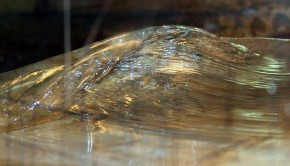
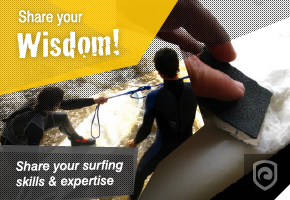










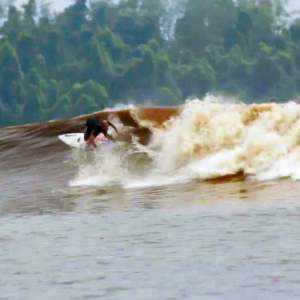
Pingback: River Surfing versus Wave Pools: Geht unsere Szene den Bach runter?